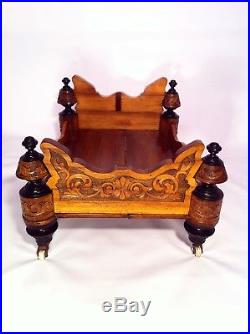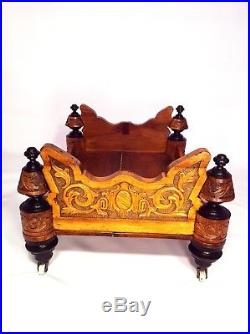Antique Doll Bed Fits 18 American Girl Victorian Salesman Sample furniture







Up for sale is this amazing doll bed. I really didnt want to get rid of it because its just an amazing piece that will only increase in value, but I have been told I need to make room for more important things. If you are an American Girl Doll collector then your in luck because an 18 inch doll will fit in this bed. Obviously this is not officially. However, if you wanted your doll to have the most luxurious.
Bed possible, then this would be it. And TRUST ME, no one is going to have anything even as remotely cool as this bed. So dont be shy because its going to be your only chance to own something this unique or beautiful. Exterior dimensions: 22.5 inches long X 16.5 inches wide X 10.5 inches high.
Bed Interior Dimensions: 19 (1/8) inches x 13 (3/8) inches. I go to auctions in my area as a hobby. The stuff that I don't put in my collection or doesn't fit in my collection, I sell. I sell so that these items can find a home where they are appreciated instead of sitting in a box at my house.As a collector myself, I know how much I appreciate when people make items available that would have otherwise been lost. I don't do this for a living, this is just an extension of my hobby. My goal is to make this a pleasurable experience for both of us. So if you have any questions or concerns just send me a message. I have a busy schedule but will do my best to answer them as soon as possible.
Related Information and Key Words: (Usually from Wikipedia). The Historical Characters line of 18-inch dolls were initially the main focus of Pleasant Company, which were initially derived from the 18-inch dolls made by Götz. In Germany during the late 1980s to the 1990s. This product line aims to teach aspects of American history through a six-book series from the perspective of a girl living in that time period. Although the books are written for girls who are at least eight years old, they endeavor to cover significant topics such as child labor.In manners appropriate for the understanding and sensibilities of their young audience. In 1995 Pleasant Company released a line of contemporary dolls called American Girl of Today. In 2006 the product line was renamed Just Like You ; it was changed again in 2010, to My American Girl , and in 2015 to Truly Me. This line has included sixty-eight different dolls over the years.
Each doll has a different combination of face mold, skin tone, eye color, and hair color, length, texture, and/or style. American Girl states that this variety allows customers to choose dolls that represent the individuality and diversity of today's American girls. A wide variety of contemporary clothing, accessories, and furniture is also available, and there are regular releases and retirements to update this line.
Each year, a Girl of the Year doll is released who has her own special talent. Clair, the Girl of the Year for 2008, did ice skating; and Marisol Luna, the Girl of the Year for 2005, was a dancer. Is a line of baby dolls targeted to children aged three and older. They are half the price of full-size American Girl dolls. The Bitty Twins line debuted in 2003 to represent slightly older toddlers and/or preschoolers.The Bitty Twins were the same size as the Bitty Baby dolls. They were discontinued in June 2016.
Hopscotch Hill School was released by American Girl in 2003. The dolls were 16-inch (41 cm) tall, came with jointed limbs and painted eyes, and had a slimmer overall body shape. Of the Historical Characters line dubbed as BeForever was launched in August 2014, complete with redesigned outfits, a two-volume compilation of previously-released books, and a Journey Book. For each character, with players taking the role of a present-day girl who found her way to the past. And met up with one of the Historical girls.The line also coincided with the relaunch of Samantha Parkington. Whose collection was previously discontinued in 2008. In June 2016 American Girl unveiled Wellie Wishers , a separate doll line similar to Hopscotch Hill School aimed for younger children and with a focus on the outdoors, positioning it between Bitty Baby and the BeForever/Girl of the Year/Truly Me dolls. As the name implies, dolls from the line wear Wellington boots. And have a body design distinct from the classic, Götz-derived American Girl dolls.
The line was released on June 23, 2016. The names of the Wellie Wishers are: Willa, Camille, Kendall, Emerson, and Ashlyn. Main article: List of American Girl characters. Main article: American Girl films.
In 2004, American Girl teamed with Julia Roberts. S Red Om production company and to create the first American Girl direct-to-video. Movie, Samantha: An American Girl Holiday.
The film spawned a franchise that was followed by Felicity: An American Girl Adventure. (2005), Molly: An American Girl on the Home Front. (2006), along with the 2008 theatrically released film Kit Kittredge: An American Girl. Premiered An American Girl: Chrissa Stands Strong. In July 2012 American Girl released a direct-to-video.
Movie, McKenna Shoots for the Stars. A seventh movie based on Saige Copeland's stories entitled Saige Paints the Sky.
Was released in July 2013, and a television film entitled Isabelle Dances Into the Spotlight. Based on Girl of the Year 2014 Isabelle Palmer, was released in 2014. A ninth film based on 2015 Girl of the Year Grace Thomas was released under the title An American Girl: Grace Stirs Up Success. With Olivia Rodrigo playing the title role. A live-action web special based on Melody Ellison's stories entitled An American Girl Story - Melody 1963: Love Has to Win was released by Amazon. Love Has to Win was then followed by An American Girl Story - Maryellen 1955: Extraordinary Christmas , starring Alyvia Alyn Lind. As Maryellen Larkin and released by Amazon on November 25, 2016. American Girl Place in The Grove at Farmers Market. American Girl Place is a store that sells American Girl dolls, clothes, and accessories. The flagship and first store debuted in Chicago followed by stores in New York City and Los Angeles. A number of boutiques followed which are smaller than the main stores; they feature rotating stock and some have casual restaurants. There are smaller stores in North Point Mall. Natick Mall in Natick, Massachusetts. Metropolitan area; and in Scottsdale, Arizona. In May 2014, Mattel American Girl opened new stores in Toronto, Ontario. In partnership with Indigo Books and Music. The company has also expressed interest in other overseas ventures, as they are seeing orders from Europe and Latin America. The company has also announced that they're expanding their operations in Mexico, with two stores at El Palacio de Hierro. And a third in Polanco.At the Ala Moana Center, running from October 4, 2014, to April 2015. During the 2015 holiday season and early 2016, temporary locations opened in San Diego, California. From approximately October 2015 to early 2016. In August of 2016 a temporary location was set up in Novi, Michigan a suburb of Detroit in Twelve Oaks Mall which closed on January 28th 2017. The American Girl magazine is run by the American Girl company.
It was started by the Pleasant Company in Middleton, Wisconsin. With the first issue dated January 1993.
Aimed towards girls ages 8-14, the bimonthly magazine includes articles, recipes, advice columns, fiction, arts and crafts, and activity ideas. Girls can choose to either get a year of magazines (6 issues), or two years of magazines (12 issues). American Girl launched Innerstar University, an online virtual world featuring the My American Girl contemporary doll line, on July 13, 2010.
In 2015, when My American Girl dolls were changed to Truly Me dolls, this website was closed down. The launch was simultaneous with Shine on Now, a fund-raising effort Kids In Distressed Situations. National Association of Children's Hospitals and Related Institutions.
These contributions are mainly through its Project Playhouse program. Some aspects of the doll's characters and history have also provoked controversy. Some observers questioned why Addy, American Girl's first African-American historical character, was portrayed first as a slave in later stories Addy and her family gain their freedom after the Civil War. , while Cecile Rey, American Girl's second black historical character, was portrayed as a well-to-do black girl.In 2005, residents of Pilsen. A neighborhood in Chicago, Illinois. Criticized a passage in the book associated with the Latina-American doll Marisol, claiming it inaccurately depicted their neighborhood as dangerous.
A senior public relations associate for American Girl responded to critics saying: We feel that this brief passage has been taken out of context in the book. The 2009 limited-edition release of Gwen, a homeless American Girl character, was also controversial. In 2005, some pro-life and Catholic.
Groups criticized the company for donating funds to the organization Girls, Inc. Which supports underprivileged girls and promotes abortion rights and acceptance of homosexuality. The American Girl Place store in New York City. Was the center of a labor dispute with Actors' Equity Association. On August 3, 2006, 14 of the 18 adult actors at the store's now defunct theater went on strike. AEA reached a two-year contract effective April 1, 2008. All American Girl Place theatres were subsequently closed in September of that year. In May 2014, the company was met with criticism on social media over its decision to discontinue four characters from the historical collection, two of them, namely African-American Cécile Rey and Chinese-American Ivy Ling, representing ethnic minorities.They however defended their move as a business decision, as they decided to "move away from the character-friend strategy within the line". The company has also drawn criticism for its recent focus on the contemporary line, specifically the Girl of the Year characters and their backstory, to which was viewed as lacking depth and more important issues in comparison to the Historical/BeForever characters' backstories.
My Little Pony: Friendship is Magic. American Girl attracted considerable criticism in February 2017 when they announced that they will be changing the dolls' bodies to incorporate permanently stitched panties. On contemporary dolls and certain BeForever character dolls, namely Maryellen, Melody and Julie. Public reaction to the permanent underwearthe first major change since the transition to flesh-colored bodies in 1991 following the release of the Felicity dollwas overwhelmingly negative. As fans of the franchise complained that it stifles customization and devalued a well-established and successful brand from heirloom quality to be passed down for generations to low-quality retail.
The company then reversed its decision in a Facebook. Stating that any existing or upcoming dolls from the line will revert to the old body design. In addition, the company has switched back to the old "iconic boutique box" packaging following complaints by collectors who deemed the new boxes to be inferior and more susceptible to damage. YouTube videos made with American Girl Dolls are becoming increasingly popular. In 2015 the American Girl fan community, more specifically the practice of creating and uploading doll-based stop motion.
Videos, was featured in a news report for BBC News. Trending site, along with interviews and videos from several prominent doll community members. Besides stop-motion animations and music videos set to popular music.
The report covers recurring subject matters in the said clips such as cyberbullying. And other social issues among children and teenagers, along with doll customization, photoshoots and unboxing videos showing new and discontinued clothes, accessories and dolls from the company.
Besides YouTube, social media services such as Instagram. Serve as platforms for fans of the toy line, spawning a community called AGIG, or American Girl Instagram, who photograph their dolls and post their photos on the service. Although mostly made up of girls usually around the age of 12-18, a number of boys and adults also participate and congregate on AGIG.
American Girl's teenage fans, particularly ones on AGTube and AGIG, will meet up with other fans at American Girl stores. At the release of Lea Clark and Gabriela McBride, certain prominent community members were included in the "Clue" videos released by American Girl. At the release of Z Yang, American Girl hosted meetups at their New York City flagship store and at their Dallas location. A Girl for All Time. A doll is a model of a human being, often used as a toy for children.
Dolls have traditionally been used in magic and religious rituals throughout the world, and traditional dolls made of materials such as clay and wood are found in the Americas, Asia, Africa and Europe. The earliest documented dolls go back to the ancient civilizations of Egypt, Greece and Rome. The use of dolls as toys was documented in Greece around 100 AD.
They have been made as crude, rudimentary playthings as well as elaborate art. Modern doll manufacturing has its roots in Germany, from the 15th century. With industrialization and new materials such as porcelain and plastic, dolls were increasingly mass-produced. During the 20th century, dolls became increasingly popular as collectibles. History, types and materials Edit.Early history and traditional dolls Edit. A typical Egyptian paddle doll from 2080 1990 BC. The earliest dolls were made from available materials such as clay, stone, wood, bone, ivory, leather, or wax. Archaeological evidence places dolls as the foremost candidate for the oldest known toy.
Wooden paddle dolls have been found in Egyptian tombs dating to as early as the 21st century BC. Dolls with movable limbs and removable clothing date back to at least 200 BC. Greek dolls were made of clay and articulated at the hips and shoulders.
There are stories from ancient Greece around 100 AD that show that dolls were used by little girls as playthings. [1] In Rome, dolls were made of clay, wood or ivory. Dolls have been found in the graves of Roman children.Like children today, the younger members of Roman civilization would have dressed their dolls according to the latest fashions. When Greek and Roman girls got married they would dedicate their doll to a goddess. [2] Rag dolls are traditionally home-made from spare scraps of cloth material.
Roman rag dolls have been found dating back to 300 BC. Traditional dolls are sometimes used as children's playthings, but they may also have spiritual, magical and ritual value. There is no defined line between spiritual dolls and toys. In some cultures dolls that had been used in rituals were given to children.
They were also used in children's education and as carriers of cultural heritage. In other cultures dolls were considered too laden with magical powers to allow children to play with them. African dolls are used to teach and entertain; they are supernatural intermediaries, and they are manipulated for ritual purposes. Their shape and costume vary according to region and custom. Dolls are frequently handed down from mother to daughter.
Akuaba are wooden ritual fertility dolls from Ghana and nearby areas. The best known akuaba are those of the Ashanti people, whose akuaba have large, disc-like heads. Other tribes in the region have their own distinctive style of akuaba. Japanese hina dolls, displayed during the Hinamatsuri festival.
There is a rich history of Japanese traditional dolls dating back to the Dog figures (8000200 BC) and Haniwa funerary figures (300600 AD). By the eleventh century, dolls were used as playthings as well as for protection and in religious ceremonies. During Hinamatsuri, the doll festival, hina dolls are displayed. These are made of straw and wood, painted, and dressed in elaborate, many-layered textiles. Daruma dolls are spherical dolls with red bodies and white faces without pupils.
They represent Bodhidharma, the East Indian who founded Zen, and are used as good luck charms. Wooden Kokeshi dolls have no arms or legs, but a large head and cylindrical body, representing little girls. The use of an effigy to perform a spell on someone is documented in African, Native American, and European cultures.Examples of such magical devices include the European poppet and the nkisi or bocio of West and Central Africa. In European folk magic and witchcraft, poppet dolls are used to represent a person for casting spells on that person. The intention is that whatever actions are performed upon the effigy will be transferred to the subject through sympathetic magic.
The practice of sticking pins in voodoo dolls have been associated with African-American Hoodoo folk magic. Likely the voodoo doll concept in popular culture is influenced by the European poppet dolls. [5] A kitchen witch is a poppet originating in Northern Europe. It resembles a stereotypical witch or crone and is displayed in residential kitchens as a means to provide good luck[6] and ward off bad spirits. A traditional Native American corn husk doll. Hopi Kachina dolls are effigies made of cottonwood that embody the characteristics of the ceremonial Kachina, the masked spirits of the Hopi Native American tribe. Kachina dolls are objects meant to be treasured and studied in order to learn the characteristics of each Kachina. Inuit dolls are made out of soapstone and bone, materials common to the Inuit people. Many are clothed with animal fur or skin. Their clothing articulates the traditional style of dress necessary to survive cold winters, wind, and snow. The tea dolls of the Innu people were filled with tea for young girls to carry on long journeys. Apple dolls are traditional North American dolls with a head made from dried apples.In Inca mythology, Sara Mama was the goddess of grain. She was associated with maize that grew in multiples or was similarly strange. These strange plants were sometimes dressed as dolls of Sara Mama. Corn husk dolls are traditional Native American dolls made out of the dried leaves or husk of a corncob. [8] Traditionally, they do not have a face.
The making of corn husk dolls was adopted by early European settlers in the United States. [9] Early settlers also made rag dolls and carved wooden dolls, called Pennywoods. [10] La última muñeca, or "the last doll", is a tradition of the Quinceañera, the celebration of a girl's fifteenth birthday in parts of Latin America. During this ritual the quinceañera relinquishes a doll from her childhood to signify that she is no longer in need of such a toy. [11] In the United States, dollmaking became an industry in the 1860s, after the Civil War.
A set of Russian Matryoshka dolls taken apart. Matryoshka dolls are traditional Russian dolls, consisting of a set of hollow wooden figures that open up and nest inside each other. They typically portray traditional peasants and the first set was carved and painted in 1890. [13] In Germany, clay dolls have been documented as far back as the 13th century, and wooden doll making from the 15th century. [14] Beginning about the 15th century, increasingly elaborate dolls were made for Nativity scene displays, chiefly in Italy. [16] The German and Dutch peg wooden dolls were cheap and simply made and were popular toys for poorer children in Europe from the 16th century. [17] Wood continued to be the dominant material for dolls in Europe until the 19th century. [18] Through the 18th and 19th centuries, wood was increasingly combined with other materials, such as leather, wax and porcelain and the bodies made more articulate.[18] It is unknown when dolls' glass eyes first appeared, but brown was the dominant eye color for dolls up until the Victorian era when blue eyes became more popular, inspired by Queen Victoria. Dolls, puppets and masks allow ordinary people to state what is impossible in the real situation;[20] In Iran for example during Qajar era, people criticised the politics and social conditions of Ahmad-Shah's reign via puppetry without any fear of punishment. [21] According to the Islamic rules, the act of dancing in public especially for women, is a taboo.
But dolls or puppets have free and independent identities and are able to do what is not feasible for the real person. Layli (Lurish doll) is a hinged dancing doll, which is popular among the Lur people of Iran. [22][23] The name Layli is originated from the middle east folklore and love story; Layla and Majnun. Layli dolls from Mamasani, Iran. Layli is the symbol of the beloved who is spiritually beautiful.
[24] Layli also represents and maintains a cultural tradition, which is gradually vanishing in urban life. Stargazer Lottie Doll was the first doll to enter space, voyaging alongside British ESA Astronaut Tim Peake. Lottie spent 264 days aboard the International Space Station during the Principa Mission. She was designed by 6-year old Abigail from Canada, when she decided she wanted to help kids become more interested in space and astronomy.
During the 19th century, dolls' heads were often made of porcelain and combined with a body of leather, cloth, wood, or composite materials, such as papier-mâché or composition, a mix of pulp, sawdust, glue and similar materials. [25][26] With the advent of polymer and plastic materials in the 20th century, doll making largely shifted to these materials. The low cost, ease of manufacture, and durability of plastic materials meant new types of dolls could be mass-produced at a lower price.
The earliest materials were rubber and celluloid. From the mid-20th century, soft vinyl became the dominant material, in particular for children's dolls. [27][28] Beginning in the 20th century, both porcelain and plastic dolls are made directly for the adult collectors market. Synthetic resins such as polyurethane resemble porcelain in texture and are used for collectible dolls. A German bisque doll from around 1900.Colloquially the terms porcelain doll, bisque doll and china doll are sometimes used interchangeably. But collectors make a distinction between china dolls, made of glazed porcelain, and bisque dolls, made of unglazed bisque porcelain. A typical antique china doll has a white glazed porcelain head with painted molded hair and a body made of cloth or leather.
The name comes from china being used to refer to the material porcelain. [29][30][31] Parian dolls were also made in Germany, from around 1860 to 1880. They are made of white porcelain similar to china dolls but the head is not dipped in glaze and has a matte finish.
[32] Bisque dolls are characterized by their realistic, skin-like matte finish. They had their peak of popularity between 1860 and 1900 with French and German dolls. Antique German and French bisque dolls from the 19th century were often made as children's playthings, but contemporary bisque dolls are predominantly made directly for the collectors market. Up through the middle of the 19th century, European dolls were predominantly made to represent grown-ups. Childlike dolls and the later ubiquitous baby doll did not appear until around 1850.
[31][34] But, by the late 19th century, baby and childlike dolls had overtaken the market. [31] Realistic, lifelike wax dolls were popular in Victorian England. Paper doll portraying actress Norma Talmadge and some of her film costumes, 1919. Paper dolls are cut out of paper, with separate clothes that are usually held onto the dolls by folding tabs. They often reflect contemporary styles, and 19th century ballerina paper dolls were among the earliest celebrity dolls.
Small celluloid Kewpie dolls, based on illustrations by Rose O'Neill, were popular in the early 20th century. Madame Alexander created the first collectible doll based on a licensed character Scarlett O'Hara from Gone with the Wind. Contemporary dollhouses have their roots in European baby house display cases from the 17th century. Early dollhouses were all handmade, but, following the Industrial Revolution and World War II, they were increasingly mass-produced and became more affordable. Children's dollhouses during the 20th century have been made of tin litho, plastic, and wood.Contemporary houses for adult collectors are typically made of wood. The earliest modern stuffed toys were made in 1880.
They differ from earlier rag dolls in that they are made of plush furlike fabric and commonly portray animals rather than humans. Various antique to modern black dolls. Black dolls have been designed to resemble dark-skinned persons varying from stereotypical to more accurate portrayals. Rag dolls made by American slaves served as playthings for slave children.Golliwogg was a children's book rag doll character in the late 19th century that was widely reproduced as a toy. The doll has very black skin, eyes rimmed in white, clown lips, and frizzy hair, and has been described as an anti-black caricature. [39] Early mass-produced black dolls were typically dark versions of their white counterparts. The earliest American black dolls with realistic African facial features were made in the 1960s. The first Barbie fashion doll from 1959.
Fashion dolls are primarily designed to be dressed to reflect fashion trends and are usually modeled after teen girls or adult women. The earliest fashion dolls were French bisque dolls from the mid-19th century. Contemporary fashion dolls are typically made of vinyl. Barbie, from the American toy company Mattel, dominated the market from her inception in 1959. [40] Bratz was the first doll to challenge Barbie's dominance, reaching forty percent of the market in 2006.
Plastic action figures, often representing superheroes, are particularly popular among boys. [42] Fashion dolls and action figures are often part of a media franchise that may include films, TV, video games and other related merchandise. Bobblehead dolls are collectible plastic dolls with heads connected to the body by a spring or hook[43] in such a way that the head bobbles. They often portray baseball players or other athletes. A reborn doll, customized to realistically portray a human baby.
With the introduction of computers and the Internet, virtual and online dolls appeared. These are often similar to traditional paper dolls and enable users to design virtual dolls and drag and drop clothes onto dolls or images of actual people to play dress up. These include KiSS, Stardoll and Dollz. Reborn dolls are vinyl dolls that have been customized to resemble a human baby with as much realism as possible.
[44][45] Asian ball-jointed dolls (BJDs) are cast in synthetic resin in a style that has been described as both realistic and influenced by anime. [46][47][48] Asian BJDs and Asian fashion dolls such as Pullip and Blythe are often customized and photographed. The photos are shared in online communities. [49][50] Custom dolls can now be designed on computers and tablets and then manufactured individually using 3D printing. Uses, appearances and issues Edit.
Early-20th century Colorado girl with a doll. Since ancient times, dolls have played a central role in magic and religious rituals and have been used as representations of deities. Dolls have also traditionally been toys for children. Dolls are also collected by adults, for their nostalgic value, beauty, historical importance or financial value. [52] Antique dolls originally made as children's playthings have become collector's items.
Dolls have traditionally been made as crude, rudimentary playthings as well as with elaborate, artful design. [54] They have been created as folk art in cultures around the globe, and, in the 20th century, art dolls began to be seen as high art. Artist Hans Bellmer made surrealistic dolls that had interchangeable limbs in 1930s and 1940s Germany as opposition to the Nazi party's idolization of a perfect Aryan body. [52] East Village artist Greer Lankton became famous in the 1980s for her theatrical window displays of drug addicted, anorexic and mutant dolls.Lifelike or anatomically correct dolls are used by health professionals, medical schools and social workers to train doctors and nurses in various health procedures or investigate cases of sexual abuse of children. Artists sometimes use jointed wooden mannequins in drawing the human figure. Swiss Egli-Figuren displaying a Bible story.
Egli-Figuren are a type of doll that originated in Switzerland in 1964 for telling Bible stories. In Western society, a gender difference in the selection of toys has been observed and studied. Action figures that represent traditional masculine traits are popular with boys, who are more likely to choose toys that have some link to tools, transportation, garages, machines and military equipment. Dolls for girls tend to represent feminine traits and come with such accessories as clothing, kitchen appliances, utensils, furniture and jewelry. Pediophobia is a fear of dolls or similar objects. [60][61] Psychologist Ernst Jentsch theorized that uncanny feelings arise when there is an intellectual uncertainty about whether an object is alive or not. Sigmund Freud further developed on these theories. [62] Japanese roboticist Masahiro Mori expanded on these theories to develop the uncanny valley hypothesis: if an object is obviously enough non-human, its human characteristics will stand out and be endearing; however, if that object reaches a certain threshold of human-like appearance, its non-human characteristics will stand out, and be disturbing. Rag doll characters Raggedy Ann and Raggedy Andy, illustrated by Johnny Gruelle, 1920. A doll hospital is a workshop that specializes in the restoration or repair of dolls. [64] Doll hospitals can be found in countries around the world. [65] One of the oldest doll hospitals was established in Lisbon, Portugal in 1830, [65] and another in Melbourne, reputedly the first such establishment in Australia, was founded in 1888.[64] There is a Doll Doctors Association in the United States. [66] Henri Launay, who has been repairing dolls at his shop in northeast Paris for 43 years, says he has restored over 30,000 dolls in the course of his career. Most of the clients are not children, but adults in their 50s and 60s. [53] Some doll brands, such as American Girl and Madame Alexander, also offer doll hospital services for their own dolls.
The item "Antique Doll Bed Fits 18 American Girl Victorian Salesman Sample furniture" is in sale since Tuesday, January 23, 2018. This item is in the category "Dolls & Bears\Dolls\Furniture\Vintage (Pre-1970)". The seller is "jtj29908" and is located in Chagrin Falls, Ohio. This item can be shipped to United States, Canada, United Kingdom, Denmark, Romania, Slovakia, Bulgaria, Czech republic, Finland, Hungary, Latvia, Lithuania, Malta, Estonia, Australia, Greece, Portugal, Cyprus, Slovenia, Japan, China, Sweden, South Korea, Indonesia, Taiwan, Thailand, Belgium, France, Hong Kong, Ireland, Netherlands, Poland, Spain, Italy, Germany, Austria, Russian federation, Israel, Mexico, New Zealand, Philippines, Singapore, Switzerland, Norway, Saudi arabia, Ukraine, United arab emirates, Qatar, Kuwait, Bahrain, Croatia, Malaysia, Chile, Colombia, Costa rica, Dominican republic, Panama, Trinidad and tobago, Guatemala, El salvador, Honduras, Jamaica, Antigua and barbuda, Aruba, Belize, Dominica, Grenada, Saint kitts and nevis, Saint lucia, Montserrat, Turks and caicos islands, Barbados, Bangladesh, Bermuda, Brunei darussalam, Bolivia, Ecuador, Egypt, French guiana, Guernsey, Gibraltar, Guadeloupe, Iceland, Jersey, Jordan, Cambodia, Cayman islands, Liechtenstein, Sri lanka, Luxembourg, Monaco, Macao, Martinique, Maldives, Nicaragua, Oman, Pakistan, Paraguay, Reunion.
- Features: Antique
- Brand: Handmade
